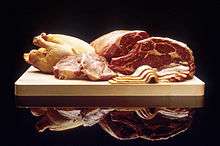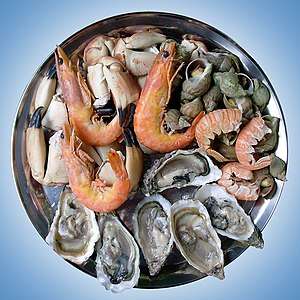Braising
Braising (from the French word braiser) is a combination-cooking method that uses both wet and dry heats: typically, the food is first sautéed or seared at a high temperature, then finished in a covered pot at a lower temperature while sitting in some (variable) amount of liquid (which may also add flavor). Braising of meat is often referred to as pot roasting, though some authors make a distinction between the two methods, based on whether additional liquid is added.[1][2]
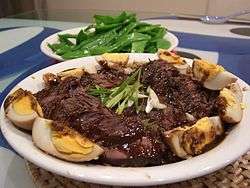
Method
Braising relies on heat, time, and moisture to break down the tough connective tissue (collagen) that binds together the muscle fibers collectively called "meat", making it an ideal way to cook tougher, more affordable cuts. Many classic braised dishes (e.g., coq au vin) are highly evolved methods of cooking tough and otherwise unpalatable foods. Both pressure cooking and slow cooking (e.g. in a crockpot) are forms of braising.
Techniques
Most braises follow the same basic steps. The food to be braised (meats, vegetables, mushrooms, etc.) is first pan-seared to brown its surface and enhance its flavor (through the Maillard reaction). If the food will not produce enough liquid of its own, a certain amount of cooking liquid that often includes an acidic element (e.g., tomatoes, beer, balsamic vinegar, wine) is added to the pot, often with stock. A classic braise is done with a relatively whole cut of meat, and the braising liquid will cover two-thirds of the food in the pan. The dish is then covered and cooked at a very low simmer until the meat becomes so tender that it can be "cut" with just the gentlest of pressure from a fork (versus a knife). Often the cooking liquid is finished to create a sauce or gravy as well.[3][4]
Sometimes foods with high water content (particularly vegetables) can be cooked in their own juices, making the addition of liquid unnecessary.[5]
A successful braise intermingles the flavors of the foods being cooked with those of the cooking liquid. This cooking method dissolves the meat's collagen into gelatin, which can greatly enrich and thicken the liquid. Braising is economical (as it allows the use of tough and inexpensive cuts), and efficient (as it often enables an entire meal to be prepared in a single pot or pan).
Braised foods
Familiar braised dishes include pot roast, Swiss steak, chicken cacciatore, goulash, Carbonade Flamande, coq au vin, sauerbraten, beef bourguignon, beef brisket, oxtail, and tajines, among others. Braising is also used extensively in the cuisines of Asia, particularly Chinese cuisine[6] and Vietnamese cuisine, where soy sauce (or in Vietnam, soy sauce and fish sauce) is often the braising liquid.
- Braised pot roast
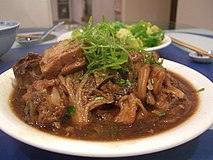 Braised pork spare ribs with preserved mustard greens
Braised pork spare ribs with preserved mustard greens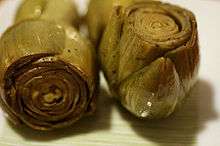
- Chinese braised pork belly
See also
| Wikimedia Commons has media related to Braising. |
References
- "Pot-Roasting". Food Resource. College of Health and Human Sciences, Oregon State University. Archived from the original on 18 July 2011. Retrieved 30 March 2009.
- "Braise". Food Resource. College of Health and Human Sciences, Oregon State University. Archived from the original on 6 May 2009. Retrieved 30 March 2009.
- Buford, Bill (2006). Heat. New York, NY, USA: Alfred A. Knopf. pp. 70–75. ISBN 978-1-4000-4120-6.
- Colicchio, Tom (2000). Think Like a Chef. Clarkson-Potter. pp. 52–63. ISBN 978-0-609-60485-4.
- Courtine, Robert J.; et al., eds. (1988) [French edition published 1984]. Larousse Gastronomique (English ed.). Paul Hamlyn. p. 133. ISBN 0-600-32390-0.
- Tropp, Barbara (1996). The Modern Art of Chinese Cooking. William Morrow Cookbooks. ISBN 978-0-688-14611-5.
